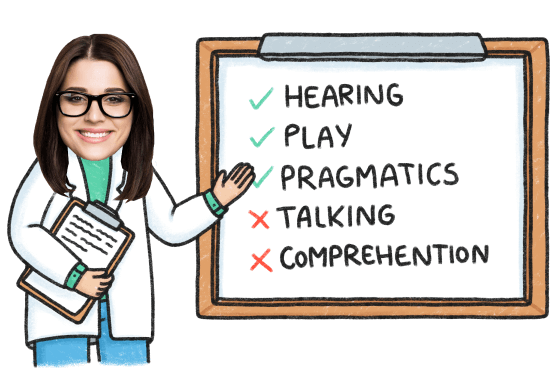Autism and Food Aversions: 5 Tips for Introducing New Food
Jan 15, 2022 Many children go through periods of picky eating or being selective about food items. For those children on the autism spectrum, food selectivity is more than simple picky eating.
While a picky eater may not like broccoli, children with autism develop food aversions that go beyond picky eating.
Scientific studies have found children within the autism spectrum are five times more likely to exhibit fewer food selections, meal-time autism tantrums, and ritualistic eating (example: foods in certain shapes). According to Autism Parenting Magazine, those with autism often limit their food options to fewer than five types of food. But why is such food selectivity found within the autism spectrum?
Expand your child’s food 🍎🥦🍗 vocabulary with Speech Blubs “Yummy Time” section
Start your free trial today and explore fun and educational activities your little one will love!
Boost Your Child’s Speech Development!
Improve language & communication skills with fun learning!

Individuals with autism often have sensory issues related to food. Brightly colored foods like peppers may cause sensory overload, which in turn leads to a food aversion to bright-colored foods. For others, certain textures like the fuzz on a peach cause an aversion to all fruit with fuzzy skin.
Sensory issues often create a picky eater. For parents of picky eaters, the main goal is to expose the child to new foods and increase their food selection.

5 Tips for Introducing New Foods
1. Don’t Pressure
No one wants to be pressured into something. The same goes for those who are picky eaters. It’s important to offer different food selections with every meal. But whether those food selections are eaten is up to the choice of the child.
Trying to convince a child to “clear the plate” will only lead to increased food aversions. Instead of convincing your child, simply explain what is on their plate and see if they eat it or not. Odds are, the new food item won’t be touched. But introducing a new food item multiple times without pressure to eat it will only increase the likelihood of your child eating it eventually.
2. Don’t Mix Foods
Since food aversions are often the result of sensory issues related to autism, intermixing foods together should be reduced. For recipes such as casseroles, there are many ingredients in one dish. These types of recipes could make an autistic child feel overwhelmed by multiple ingredients mixed together. Sensory overload in autism for children is real.
The best way to minimize food sensory overload is by avoiding mixing foods especially disliked foods with a liked item. For instance, if your child dislikes sausage, but loves spaghetti. Don’t combine spaghetti with bits of sausage. This will cause a child with autism to dislike both the new food item and the liked food item.
Another way to look at not intermixing foods is to not try and ‘hide’ or ‘disguise’ the food in hopes your child won’t notice and eat it.
3. Combine New and Old Favorites
To introduce new foods to expand your child’s food variety, try pairing a new food with a favorite food item. However, this doesn’t mean you need to combine the foods to hide the new ingredient.
My son loves chicken nuggets in the shape of dinosaurs with yogurt. When introducing a new item, I pair it with a beloved favorite like chicken nuggets and yogurt. This way I am assured he has something to eat! If I only add the new food item I know it won’t get touched or eaten, and I’ll still have to make a different meal to make sure he’s had something to eat.
4. Eat the Same New Food
Set an example by showing your child that the new food item tastes yummy. This is a simple trick to introducing new food items for children with food aversions. While it does not work immediately, your child will come to understand that you too have more food options that you like as well. Eventually, seeing you eat the new food may help your child eat it!
One of my favorite snacks is roasted chickpeas. When I first introduced them to my son, he wanted nothing to do with them!
Over time, he continued to see me eat chickpeas and finally tried one. Today, roasted chickpeas are one of his favorite snacks! Persistence is key to this step!
5. Allow Them to Explore
Often the source of food aversions is texture and smell. If a child is not used to a new food texture or its smell, the food is avoided. As a parent, we tend to discourage children from playing with their food. But if a child has a sensory issue, play is essential for introducing new foods.
Allow your child to feel, taste, smell, and explore the new food item! In fact, encourage it! Those with autism process the world around them differently. They need to play with food to know what it is and if they would like it or not.

My son hates pasta. Not because he doesn’t like the taste, but because he doesn’t like the texture of noodles. To help him overcome the texture of noodles, I let him touch and play with them. He’s yet to eat pasta, but at least he touches noodles now to move them off his plate instead of crying about it. To me, that’s a success!
Don’t freak out!
Food aversions are common for everyone. But for children with autism, food aversions are more than mere picky eating. A child without a variety of different foods can suffer nutritional deficiencies. For children with autism, this becomes a concern when only a small number of food items are eaten.
To add more variety, new foods need to be introduced even if your child never eats them. What’s important is to keep offering new foods! Don’t get into the pattern of only offering the same favorite foods. But use your child’s favorite foods to your advantage to pair with new food items.

